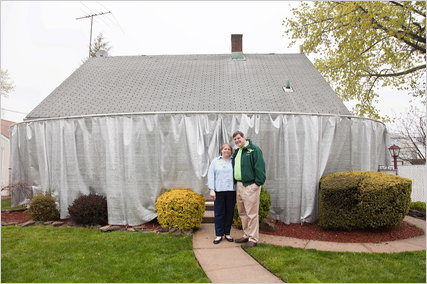A Sustainable Way of Life Becomes the Curriculum! Part 5
By Brian Skeele, on May 25th, 2011
Imagine. An elementary school and the surrounding neighborhoods joining together to become a sustainable community with the school at its heart.

Biologies on the roots, detoxify water!
Science Rules! Tapping into the Power of Biologies; Community Composting and Recycling Water – Part 5
Throughout the neighborhood, attached greenhouses provide essential composting, soil studies and crop production opportunities. The solar recharged neighborhood electric cart collection service gives teens an opportunity to make money by driving household food scraps to the community composting bins.
“Living Machines,” water recycling tanks, demonstrate how bacteria and microorganisms purify water.
Living Machines, invented by Dr. John Todd, use plants and microbes to clean water instead of chemicals. They can handle household waste, and easily tackle industrial wastes, turning 600 to 750,000 gallons of waste per day into hyacinths and snails… Dr. Todd (a student of Bucky Fuller BTW), has been working with Living Machines for decades has found that there are certain plants or small animals that love certain kinds of waste. What he does is let the water run through a series of cisterns with different plants in each. What one plant likes to eat, it turns into other forms of waste, so in the next cistern he has the plant that considers that waste food. By the time the water comes out, it’s 5 times cleaner than traditional waste water treatment….
Part 1
Part 2
Part 3
Part 4
Part 5
READ MORE >>
Renovate Your House, Transform the Neighborhood
By Brian Skeele, on May 9th, 2011
Washing machines sit idle most of the time
Looking at the challenge of how to build our futures resilient and sustainable, my sense is the insulation in the burbs across America is woefully shy. Heating systems are not so efficient, heating ducts leak, appliances are not so energy efficient, and windows are not so good, to say the least. These aren’t really economic problems until we hit global peak oil production. Then the pain of rising prices, utility bills, and commuting will become increasingly excruciating, is my guess.

What service would you like to provide to the neighborhood? Originally, the “dress” on House #1 was meant to conceal a gambling casino.
The cost of renovating a suburban home to a highly efficient passive (zero or low emissions) house is cost preventative in many situations. My sense is most suburbanites will only be able to make these upgrades if they can bundle the costs as they add a second, third, four stories to their homes. To make this scenario work, the first floor will become mostly commercial, home occupation, and the floors above will contain rentals, offices or residential, maybe multigenerational families with multiple contributions to the mortgage. The densities in the neighborhood have to be high enough to make the commercial successful.
I wouldn’t be surprised if the numbers for this “2-4 story smart density infill/renovation to passive home standards” will only work if these free standing suburban homes are joined to create row houses. My guess is the cost challenge of upgrading from an R 13 or R19 wall to a R 40? is too great a hurdle. By creating row houses, I’m thinking the amount of exterior walls is greatly reduced. Good sound insulation is essential, but much less expensive than getting to R 40 (or whatever a passive/zero emissions house design requires).
To add to the complexity,… READ MORE >>
Cap & Trade-smoke and mirrors?
By Brian Skeele, on March 19th, 2011
I’ve read a couple of articles about cap and trade, and the authors seem to think it’s bogus. Way too complicated. A boondoggle to make the same clever people who brought us the foreclosure bummer even richer.
Here’s Anne Leonard’s take on it.
The idea I like is to tax carbon, and lift taxes on income. In this way, folks will be encouraged to take their savings and invest in renewable energy. I cannot believe how happy newspaper stories report on increase fossil fuel production, or the good news about nuclear energy…What planet are these people living on???… READ MORE >>
Fuels-pick your poison!
By Brian Skeele, on March 19th, 2011
Nuclear, coal, natural gas, methane, biochar oil, ethanol, algae bio-diesel, the sun, the tides, the wind, or good old gasoline…each comes with its costs. As we innovate toward a sustainable lifestyle, the refining processes and embedded energy, the delivery system, and all the other externalities come into play.
Currently 60% of the US’s primary electricity comes from coal fired plants. The burning of coal releases mercury into the air. The fish in New Mexico have quite a bit of mercury in them, especially those located downwind from the Four Corners Generating Plants. Fish in the Pacific Ocean have high levels of mercury as well, as the mercury bio-accumulates in the bigger fish, like tuna. The Chinese coal fired plants are the mercury source for our sushi and salmon!
Agricultural crops converted to fuels come with GMOs, fertilizer run off, soil degradation, and embodied production and delivery costs. Local production and supply keeps dollars in the community, building wealth and cutting transportation costs. Talk about complicated…. READ MORE >>
